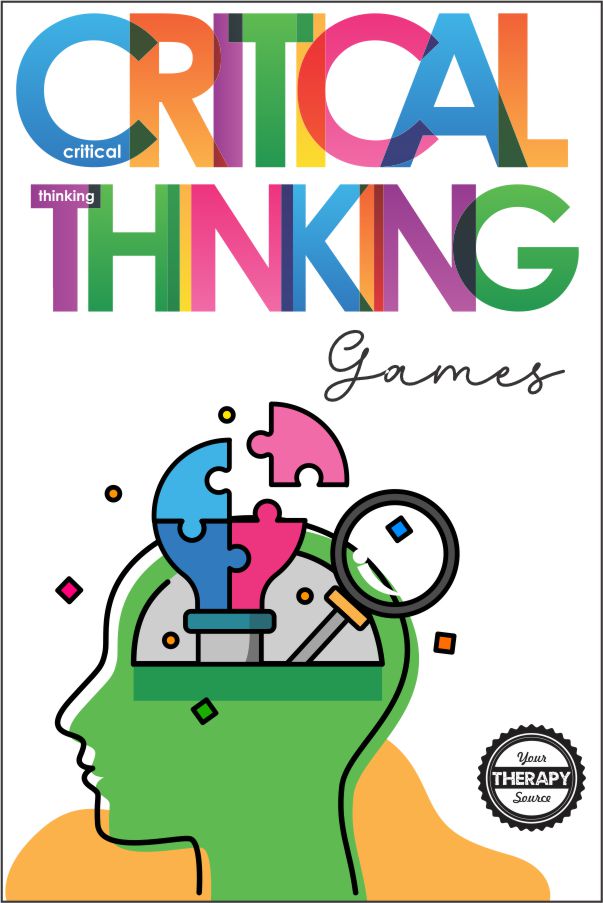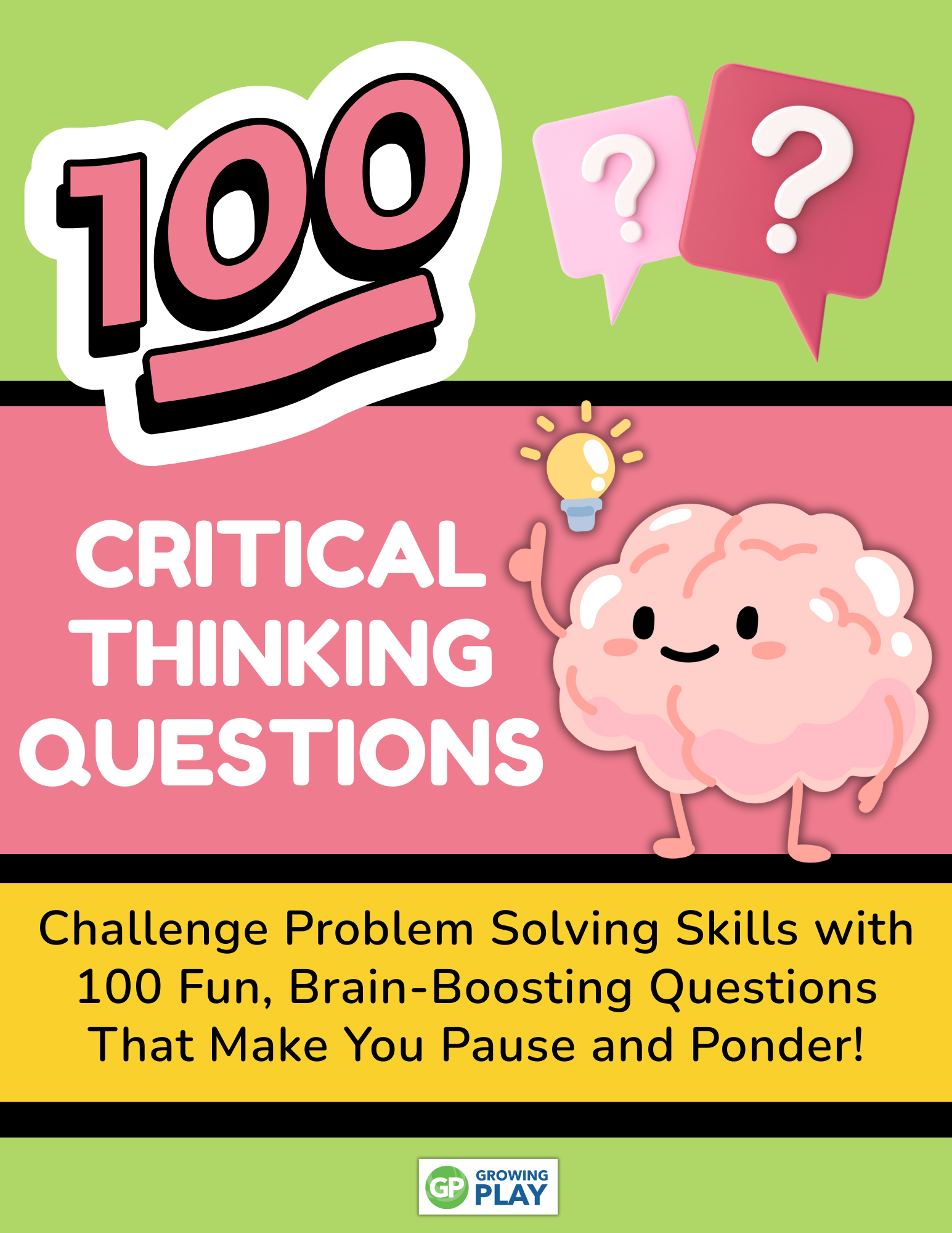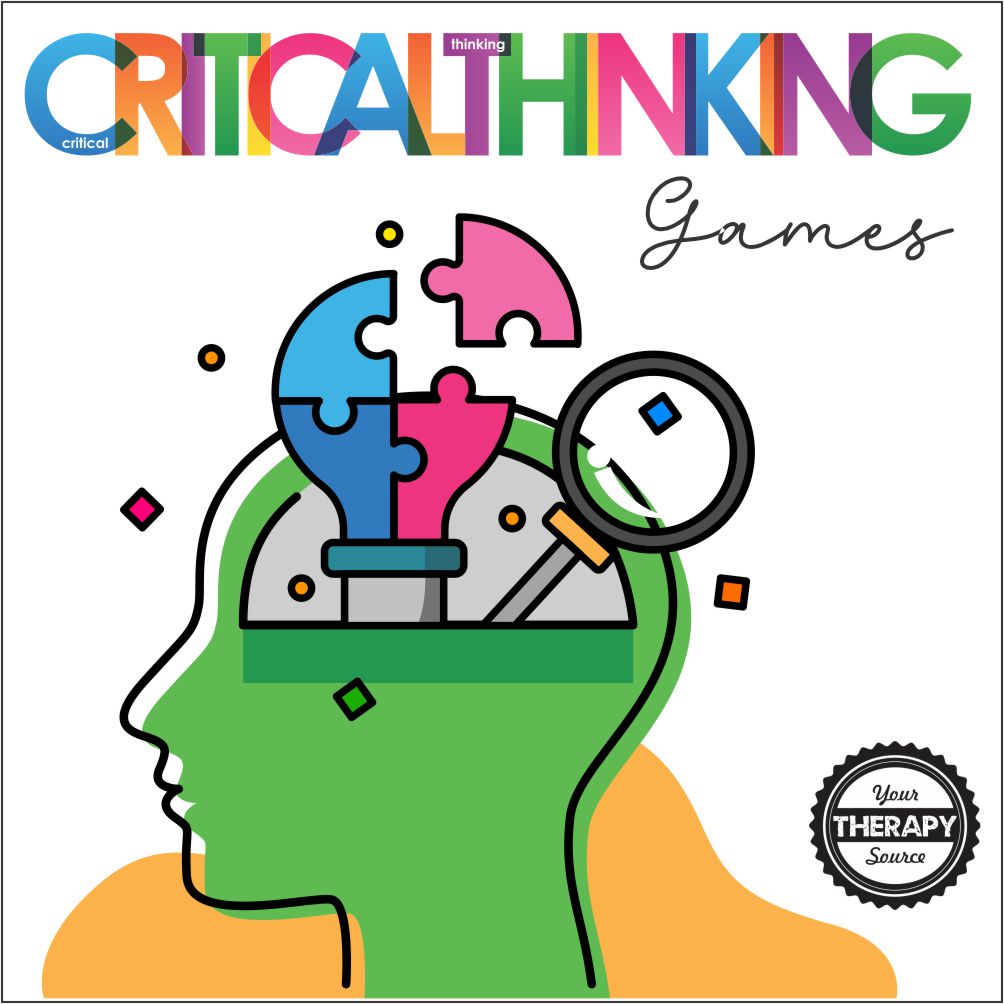Critical Thinking Games

If you’re looking for an engaging way to develop critical thinking skills in the classroom, you’ll want to consider critical thinking games. Games are a great educational tool to help students develop their higher-order thinking skills. They allow students to experiment and practice decision-making in a series of playful tasks. From role-playing activities to puzzles, these fun and rewarding mental exercises will get your students thinking outside of the box while honing their problem-solving abilities. You can download a FREE PDF of Critical Thinking Questions at the bottom of the post.
WHY ARE CRITICAL THINKING GAMES IMPORTANT?
Critical thinking games are important because they provide an engaging and fun way for students to develop their problem-solving skills. Games also allow students to practice creative thinking, brainstorming, and logical reasoning which can all be applied to real-world situations. By playing these games, students will better understand the complex theories related to critical thinking and become more proficient problem-solvers. They’ll also learn to make better decisions in the classroom and eventually their workplace.

Critical Thinking Questions
PUZZLES AS CRITICAL THINKING GAMES
One of the best ways to develop critical thinking skills is through puzzles. Puzzles provide a mental challenge that can help students develop their cognitive skills. They also allow for trial and error so that students can learn from their mistakes or come up with new ideas to solve complex problems.
Jigsaw Puzzles
Players look at a picture and then put together different pieces to complete it. This type of game promotes problem-solving skills, pattern recognition, and critical thinking as the player must pay attention to small details to complete the puzzle successfully.
Logic Puzzles
Logic puzzles are great for older students and require more advanced problem-solving skills. These games are typically set up in a grid with clues that the player must use to determine which items go in each square. This type of puzzle stimulates critical thinking as players must look for patterns and logical deductions to solve it.
ROLE-PLAYING GAMES FOR CRITICAL THINKING
Role-playing games are another great way to practice critical thinking skills. These games involve characters that interact with each other and the environment, which allows for problem-solving and creative thinking. Through role-playing games, students can learn how to think on their feet as well as develop strategic planning skills that will be useful in the future. Here are some role-playing games:
Dungeons & Dragons
Dungeons & Dragons is an iconic role-playing game that requires players to work together to solve puzzles and overcome obstacles. This type of game allows students to practice problem-solving skills as they develop their character’s story and strategies for success.
Magic: The Gathering
In Magic: The Gathering players are tasked with building their own deck of cards and playing against other opponents in a turn-based strategy game. This type of game requires players to think logically and strategically as they develop their deck and make decisions during the game.
MATH CRITICAL THINKING GAMES
Math critical thinking games can be a great way to help students learn and practice mathematical concepts. By playing math critical thinking games, students can become more comfortable with numbers while developing their problem-solving skills. Some examples of math critical thinking games are:
Sudoku
This requires players to fill in blank squares with the correct numbers in order to complete a 9×9 grid. This game encourages critical thinking because it involves finding patterns and using logic to solve the puzzle.
Battleship
In Battleship, two players take turns guessing where their opponent’s ships are located on a grid. This game encourages critical thinking as players must think strategically and use logic to guess the correct location of their opponent’s ships.
Math Memory
Math Memory is a card game where players match numbers or equations with their corresponding answer. This game allows students to practice memorizing equations while also developing their problem-solving skills.
CREATIVE CRITICAL THINKING GAMES
Creative critical thinking games are a great way to stimulate the mind and creative ideas. These games help students work through problems collaboratively, learn how to think outside of the box, and come up with innovative solutions. Working on crafts and art projects can also be a great way to practice critical thinking. Here are some creative crafts to try:
Pipe Cleaner Sculptures
Pipe cleaner sculptures are a great way to practice creative problem-solving. Players create sculptures with pipe cleaners that must fit certain criteria, such as being able to stand on its own or having three points of contact.
Marshmallow Challenge
The Marshmallow Challenge is a team-building activity that encourages creative problem-solving. Players are given a limited amount of time and materials to build the tallest free-standing structure possible using only marshmallows and spaghetti noodles.

Handwriting Prompts – 100 Questions of the Day
PROBLEM-SOLVING CRITICAL THINKING GAMES
Problem-solving activities are great critical thinking games that can be used to test abilities. These puzzles require the use of logic and creative thinking, which can help develop analytical skills. You can also consider asking students to answer some critical-thinking questions to expand their thought processes.
Brain Teasers
Brain teasers are puzzles or riddles that require players to think critically and solve problems. These types of games encourage problem-solving skills as players must work through the puzzle and come up with a solution.
Escape Rooms
Escape rooms are a great way to practice problem-solving skills in a fun environment. Players are placed in a room and must work together to find clues, solve puzzles, and escape the room within a certain amount of time. You can add a good mystery to an escape room to add to the intrigue. This type of game encourages critical thinking as players must use logic and problem-solving skills to progress through the game.
SORTING CRITICAL THINKING GAMES
Sorting critical thinking games are a great way to help students develop their problem-solving abilities. These games can involve sorting objects or categorizing items based on logical principles. By playing these types of games, students can learn how to think analytically and break down complex problems into simpler pieces.
Card Sorting Game
Players must sort cards into piles based on certain criteria, such as type of animal or color. This game encourages critical thinking as players must logically categorize the items to solve the puzzle correctly.
Shape Sorting Game
The shape sorting game involves sorting various objects and shapes into the correct slots. This type of game requires players to think logically in order to correctly place each item.
SCIENCE CRITICAL THINKING GAMES
Science critical thinking games are a great way to help students learn and practice scientific concepts. These games often involve finding patterns and analyzing data, which can help bolster problem-solving skills. Science critical thinking games are especially beneficial for younger students who are just beginning to explore the world of science.
Lego Challenge
The Lego challenge is a great way to practice critical thinking and problem-solving skills. Players are challenged to build something out of Legos that meets certain criteria, such as having three points of stability or being able to move on its own. This type of game can help students learn how to think outside of the box and come up with creative solutions.
Paper Airplane Challenge
The paper airplane challenge is a great way to encourage critical thinking skills among students. Players are challenged to create a paper airplane that can fly the furthest or stay in the air for the longest amount of time. This type of game requires players to think critically and come up with creative ways to make their plane fly better.
Egg Drop
The egg drop is a classic critical thinking game that can be used to test problem-solving skills. In this activity, players are challenged to build a structure that will keep an egg safe when it is dropped from a certain height. This type of game encourages creative problem-solving and teamwork as players must collaborate in order to come up with a successful design.
It’s clear that critical thinking games are an effective, engaging tool for developing problem-solving skills in the classroom. Whether it’s puzzles, math problems, team-building activities, or creative exercises, these fun activities and rewarding mental challenges will help your students become more proficient problem-solvers and thinkers.
20 Critical Thinking Questions to Ponder
Critical thinking questions challenge children to think deeply and articulate their thoughts and solutions. Here are 10 examples of such questions, each followed by additional prompts to encourage deeper exploration and reasoning:
- If you could solve one world problem, what would it be and why?
- How would you go about solving this problem?
- Who would you need to help you solve this problem, and why?
- Imagine you’re a detective solving a mystery. What steps would you take to solve it?
- What clues would you look for?
- How would you decide which suspects to question?
- If you could invent something to make life easier, what would it be?
- How would your invention work?
- Who would benefit most from your invention?
- Think of a time when you had a disagreement with a friend. How did you resolve it?
- What could you have done differently?
- How did the resolution affect your relationship with your friend?
- If you found a wallet on the ground, what would you do?
- How would you decide the best course of action?
- What would you do if you couldn’t find the owner?
- How would you plan a surprise party for your best friend?
- What steps would you need to take to keep it a surprise?
- How would you ensure that the party is something your friend would enjoy?
- If you could change one rule at your school, what would it be and why?
- How would your change benefit students?
- Can you think of any negative consequences of your change?
- Imagine you’re an astronaut exploring a new planet. What do you hope to find?
- How would you prepare for your journey?
- What challenges do you think you would face?
- If you could talk to animals, which animal would you talk to first and why?
- What questions would you ask the animal?
- How do you think this ability would change your perspective on animals?
- You’re designing a city of the future. What features would it have?
- How would it be different from cities today?
- What technologies would you incorporate to improve people’s lives?
- If you could design a new school subject, what would it be and why?
- What skills or knowledge would students gain from this subject?
- How would it benefit them in their daily lives and future careers?
- Imagine you’ve discovered a new planet. What is the most surprising thing about it?
- Describe the creatures that live there. How do they interact with their environment?
- What kind of weather does your planet have, and how do the inhabitants adapt to it?
- If you could create a new holiday, what would it celebrate and how?
- What traditions or activities would people do on this day?
- How would your holiday promote positive values or behaviors?
- Think of an invention that could help protect the environment. What is it and how does it work?
- Who would use your invention, and how would it change their habits?
- What challenges might you face in convincing people to use your invention?
- If you had the power to change one law of nature, what would it be and what effects would it have?
- How would animals, plants, and humans adapt to this new law?
- Could there be any unintended consequences of this change?
- Design a game that teaches players about kindness. What are the rules?
- How do players win, and what do they learn in the process?
- Can you think of a way to include players who typically have a hard time in competitive games?
- Imagine a world where everyone has the same dream at night. What is the dream about?
- How would this shared dream experience affect society and relationships?
- Would people interpret the dream differently? Why or why not?
- If you could communicate with plants, what would you ask them?
- What do you think plants would want to tell humans?
- How could this ability change the way we care for our environment?
- Create a superhero whose main power is empathy. What adventures do they go on?
- How does their power help them solve problems?
- What challenges do they face, and how do they overcome them?
- If you could build a machine that does one chore for you, what would it do and how would it work?
- Why is this chore important, and how would having it done automatically affect your daily life?
- How would you make your machine environmentally friendly?
These questions encourage kids to blend creativity with critical thinking, pushing them to consider not just the immediate implications of their ideas, but the broader impact on society, the environment, and interpersonal relationships. Encouraging children to explore such questions can foster a mindset that values thoughtful inquiry, imaginative problem-solving, and ethical reasoning.



